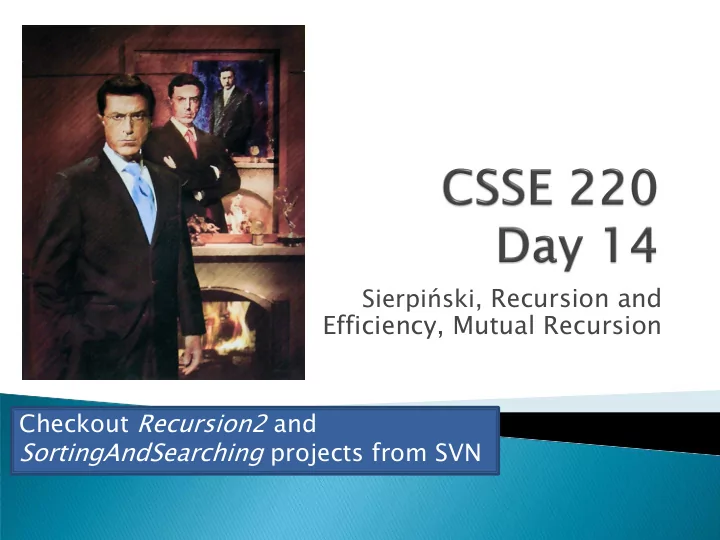

Sierpiński , Recursion and Efficiency, Mutual Recursion Checkout Recursion2 and SortingAndSearching projects from SVN
Any method that calls itself ◦ On a simpler problem ◦ So that it makes progress toward completion ◦ Indirect recursion: May call another method which calls back to it.
When implementing a recursive definition When implementing methods on recursive data structures Where parts of the whole look like smaller versions of the whole Q1
The pros ◦ easy to implement, ◦ easy to understand code, ◦ easy to prove code correct The cons ◦ Sometimes takes more space and time than equivalent iterative solution ◦ Why? because of function calls Q2
Always have a base case that doesn’t recurse Make sure recursive case always makes progress, by solving a smaller problem You gotta believe ◦ Trust in the recursive solution ◦ Just consider one step at a time
Why does recursive Fibonacci take so long?!? Can we fix it? Q3
Save every solution we find to sub - problems B efore recursively computing a solution: ◦ Look it up ◦ If found, use it ◦ Otherwise do the recursive computation Q4
A deep discovery of computer science In a wide variety of problems we can tune the solution by varying the amount of storage space used and the amount of computation performed Studied by “Complexity Theorists” Used everyday by software engineers
2 or more methods call each other repeatedly ◦ E.g., Hofstadter Female and Male Sequences ◦ In how many positions do the sequences differ among the first 50 positions? first 500? first 5,000? first 5,000,000? http://en.wikipedia.org/wiki/Hofstadter_sequence Q5
Recursion Recap of 3 Rules
Let’s see…
Shlemiel the Painter
Shlemiel gets a job as a street painter, painting the dotted lines down the middle of the road. On the first day he takes a can of paint out to the road and finishes 300 yards of the road. "That's pretty good!" says his boss, "you're a fast worker!" and pays him a kopeck. The next day Shlemiel only gets 150 yards done. "Well, that's not nearly as good as yesterday, but you're still a fast worker. 150 yards is respectable," and pays him a kopeck. The next day Shlemiel paints 30 yards of the road. "Only 30!" shouts his boss. "That's unacceptable! On the first day you did ten times that much work! What's going on?" "I can't help it," says Shlemiel. "Every day I get farther and farther away from the paint can!"
Be able to describe basic sorting algorithms: ◦ Selection sort ◦ Insertion sort ◦ Merge sort Know the run - time efficiency of each Know the best and worst case inputs for each
Basic idea: ◦ Think of the list as having a sorted part (at the beginning) and an unsorted part (the rest) ◦ Find the smallest value in the unsorted part Repeat until ◦ Move it to the end of the unsorted part is sorted part (making the empty sorted part bigger and the unsorted part smaller)
Profiling: collecting data on the run - time behavior of an algorithm How long does selection sort take on: ◦ 10,000 elements? ◦ 20,000 elements? ◦ … ◦ 80,000 elements? Q6
Analyzing: calculating the performance of an algorithm by studying how it works, typically mathematically Typically we want the relative performance as a function of input size Example: For an array of length n , how many times does selectionSort() call compareTo() ? Handy Fact Q7- Q12
In analysis of algorithms we care about differences between algorithms on very large inputs We say, “selection sort takes on the order of n 2 steps” Big - Oh gives a formal definition for “on the order of” Q13
We write f(n) = O(g(n)), and say “f is big - Oh of g” if there exists positive constants c and n 0 such that 0 ≤ f(n) ≤ c g(n) for all n > n 0 g is a ceiling on f
csse220 - 201330 - LR01,abeggleg,araujol,greenwpd csse220 - 201330 - LR02,benshorm,mcnelljd,woodjl csse220 - 201330 - LR03,daruwakj,holzmajj,kadelatj csse220 - 201330 - LR04,gauvrepd,hazzargm,songh1 csse220 - 201330 - LR05,gouldsa,malikjp,olivernp csse220 - 201330 - LR06,griffibp,heathpr,tebbeam csse220 - 201330 - LR07,litwinsh,plugerar,shumatdp csse220 - 201330 - LR08,adamoam,alayonkj,vanakema csse220 - 201330 - LR09,bochnoej,johnsotb,tatejl csse220 - 201330 - LR10,calhouaj,cheungnj,walthecn csse220 - 201330 - LR11,evansc,wagnercj,roccoma
csse220 - 201330 - LR12,haloskzd,mookher,stephaje csse220 - 201330 - LR13,hullzr,naylorbl,winterc1 csse220 - 201330 - LR14,johnsoaa,kethirs,wrightj3 csse220 - 201330 - LR15,liuj1,phillics,zhoup
Q14- 15
Recommend
More recommend